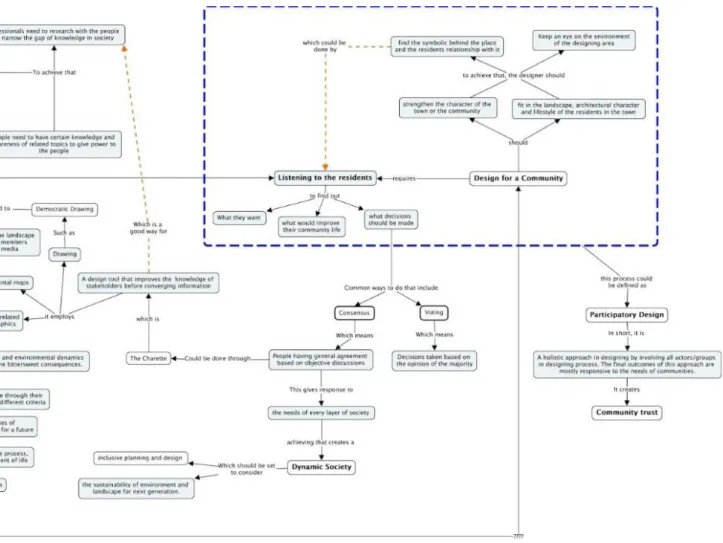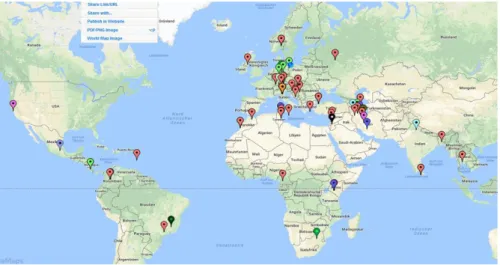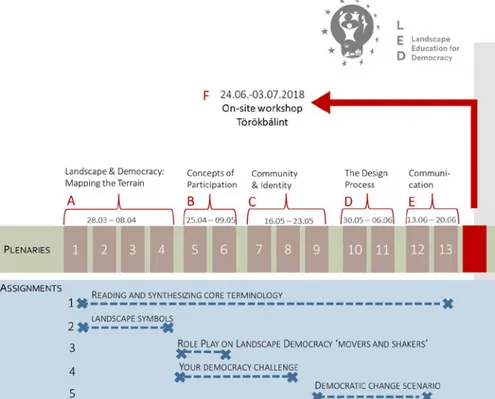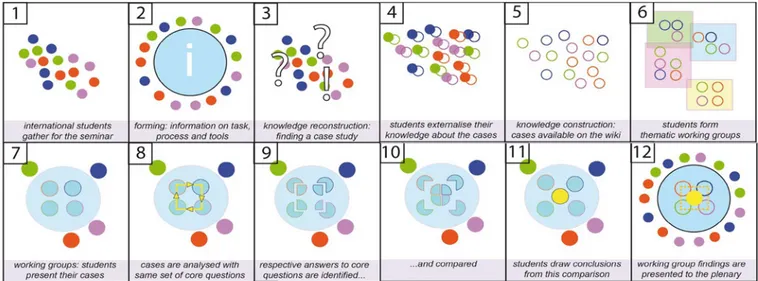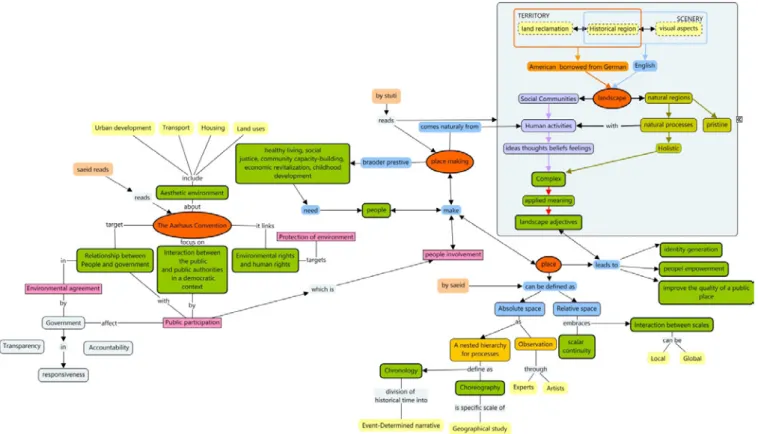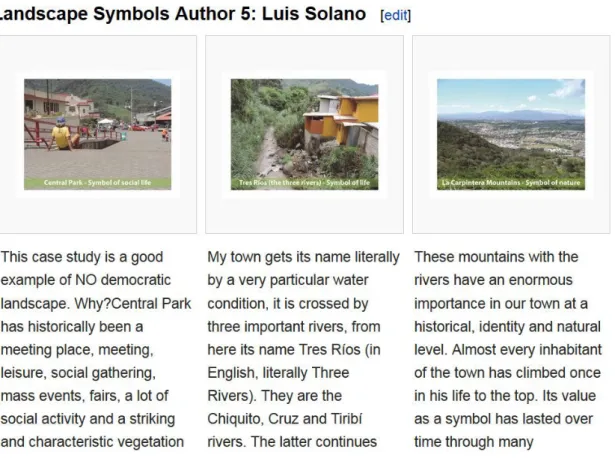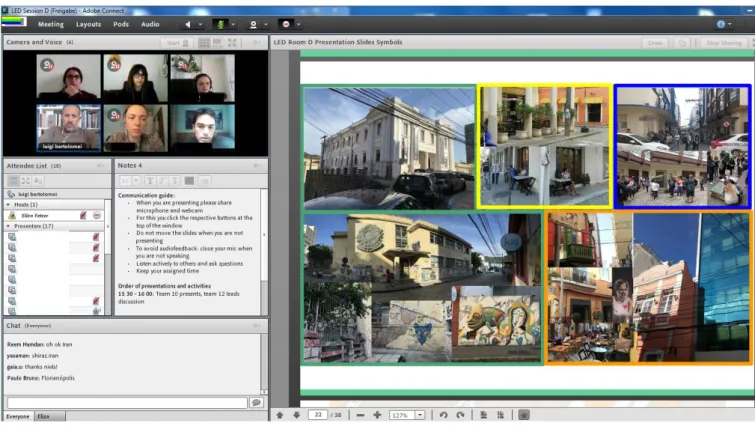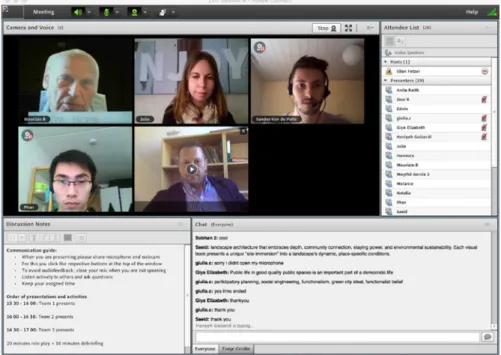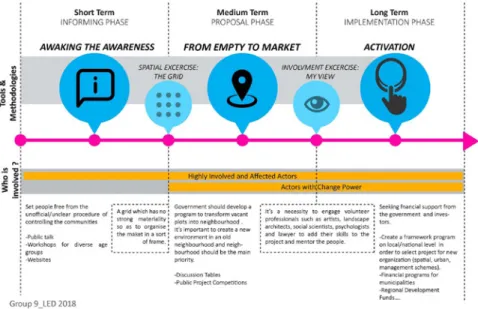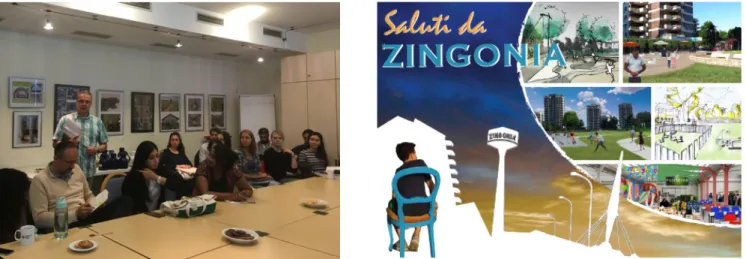ricerche e progetti per il territorio, la città e l’architettura
ISSN 2036 1602 Università di Bologna | in_bo.unibo.it
2019, n° 04
special issue 4
volume 10
Landscape Education for Democracy
Co-creating a socially-engaged landscape planning
and design education for sustainable development
A cura di / Edited by Ellen Fetzer Deni Ruggeri Autori / Authors Luigi Bartolomei Diedrich Bruns Albert Fekete Ellen Fetzer Anna Szilagyi-Nagy Nicolas Reibel Anita ReithdirEttorE rEsponsAbilE /
Editor in chiEf
Luigi Bartolomei, Università di Bologna
comitAto sciEntifico /
sciEntific committEE
Ernesto Antonini, Università di Bologna
Sérgio Barreiros Proença, CIAUD, Portogallo
Eduardo Delgado Orusco, Reset Arquitectura, Spagna
Esteban Fernández-Cobián, Universidade da Coruña, Spagna
Arzu Gönenç Sorguç, METU, Turchia
Silvia Malcovati, Politecnico di Torino/Fachhochschule
Potsdam, Italia
Sara Marini, Università Iuav di Venezia
Thomas Oles, Swedish University of Agricultural Sciences,
Svezia
Alberto Perez Gomez, McGill University, Faculty of Engineering.
School of Architecture, Montreal, Canada
Claudio Sgarbi, Carleton University, Canada
Teresa Stoppani, Architectural Association, Regno Unito
comitAto EditoriAlE /
EditoriAl boArd
Michele F. Barale, architetto PhD
Jacopo Benedetti, Università Roma 3
Andrea Conti, SLU, Uppsala
Francesca Cremasco, architetto PhD
Marianna Gaetani, Politecnico di Torino
Sofia Nannini, Politecnico di Torino
Stefano Politi, Università di Bologna
Alessandro Tognon, Università di Bologna
Matteo Vianello, Università Iuav di Venezia
Enti promotori dEl numEro / issuE promotErs
DA - Dipartimento di Architettura dell’Università di Bologna
CHGH - Centro Studi Cherubino Ghirardacci, Bologna
R3C - Responsible Risk Resilience Centre, Politecnico di
Torino
Associazione Guarino Guarini
ricerche e progetti per il territorio, la cittàe l’architettura. ISSN 2036 1602.
in_bo è una rivista digitale e open-access che pubblica contributi di ricerca nelle svariate discipline riguardanti l'architettura, l'urbanistica e l'ingegneria. Pubblica contenuti in italiano e in inglese, selezionati secondo un processo di blind peer-review. Dal 2012 è stata inserita nell’elenco ANVUR delle riviste scientifiche ai fini dell’Abilitazione Scientifica Nazionale. “in_bo” is a bilingual (Italian/English) open access e-journal, of the Department of Architecture, University of Bologna. It is indexed in the major national databases and in the most prestigious international libraries. In 2012 it has been included in ANVUR (Italian National Agency for the Evaluation of Universities and Research Institutes) list of scientific journals for the purpose of the National Scientific Qualification.
indice
index
6
Deni Ruggeri
The What, Why and How of
Landscape Education for
Democracy /
Il cosa, perché
e come del Landscape
Education for Democracy
18
Ellen Fetzer,
Deni Ruggeri
Landscape Education for
Democracy: Methods and
Methodology /
Landscape
Education for Democracy:
Metodi e Metodologia
44
Eva Schwab,
Tonje Cecilie
Stordalen
Case Studies from the Student
Groups Learning for Life? How
Participants Evaluate LEDs
Relevance and Applicability /
Casi studio dai gruppi di
studenti "Learning for Life"?
Come i partecipanti
considerano la rilevanza e
l'applicabilità dei programmi LED
58
appendice/
appendix
Albert Fekete,
Anita Reith,
Ádám Weiszer
10
Diedrich Bruns,
Luigi Bartolomei,
Deni Ruggeri, Eliza
Salman, Ellen Fetzer
LED Concepts and Theory
Nozioni e teoria del LED
34
Nicolas Reibel
Art as a Catalyst for
Landscape Democracy /
L'arte come catalizzatore per
la Democrazia del Paesaggio
52
Ellen Fetzer,
Diedrich Bruns,
Anna Szilagyi-Nagy
The Future of the Landscape
Education for Democracy
Programme /
Il futuro del
Programma Landscape
Education for Democracy
Co-funded by the
Erasmus+ Programme
of the European Union
Cofinanziato dal
Programma Erasmus+
dell'Unione Europea
The LED - Landscape Education for Democracy Project has been (partially) funded by the ERASMUS+ grant program of the European Union under grant no.2015-1-NO01-KA203-013239. Neither the
in_bo The LED Process 2019, vol. 10 n. 4
Authors
Autori
diEdrich bruns
He is Full Professor and leads the Landscape Planning & Land Use Group at the School of Architecture, Urban and Landscape Planning of Kassel University, Germany (since 1996). He is Senior Principal of ‘Landscape Ecology & Planning Consultants’ (since 1986) and completed over 400 planning and design projects, mainly for urban de-velopment, transportation, restoration of mining and flood risk management. Previous academic appointments in-clude Lecturer at Toronto University, Canada (1979/80) and Visiting Scholar at the University of California, Berkeley, USA (1986). Current teaching and re-search interests are in communicative planning approaches, with respect to inclusiveness and early public involve-ment.
EllEn fEtzEr
She holds a diploma and a PhD in landscape planning from Kassel University, Germany. Since 2001 she has been working at the School for Landscape Architecture, Environmental and Urban Planning in Nürtingen (Stuttgart area). She is primarily coordinating an international master degree in landscape architecture (IMLA). The second focus of her work is on computer-supported collaborative learning. Ellen Fetzer is an executive member of the European Council of Landscape Architecture Schools since 2004.
luiGi bArtolomEi
After his PhD in architectural compo-sition, he taught Architecture of Infra-structure and Landscape at the Un-versity of Bologna. At the Theological Faculty of Emila-Romagna he is invited professor for courses on Architecture for Religions and Belonging. Member of the Editorial Board of “Il Giornale dell’Architettura” since 2011, he is also president of Centro Studi Cherubino Ghirardacci in Bologna (www.ghirar-dacci.org), promoting relevant meeting of international interest whose procee-dings are published on IN_BO, open ac-cess scientific journal of the University of Bologna, of which L.B. is director sin-ce June 2015. Particularly well-known for his research on sacred architectu-re, LB is collaborator of the Office for Cultural Heritage of the Conference of Italian Bishops.
dEni ruGGEri
His research focuses on participation, sustainable development, and place attachment. He holds a PhD from the University of California, Berkeley and Master’s degrees from Cornell Uni-versity. He practiced landscape archi-tecture and community design interna-tionally and coordinated the Landscape Education for Democracy Erasmus + program.
nicolAs rEibEl
He is an American artist producing installations in public space, empha-sizing community engagement for planning purposes. He has degrees in Sculpture and Installation from We-stern Washington University, exhibiting since 1999. Having facilitated public discussion for Documenta 14, he now provides art mediation workshops across Europe.
AnnA szilAGyi-nAGy
Anna Szilágyi-Nagy is an MSc land-scape architect, working at the Town Hall of Törökbálint. She is interested in promoting practices that smoothen the dialogue between decision makers and citizens at the local level. She is vi-ce-president of the kultúrAktív Egyesül-et, a Hungarian NGO that fosters built environment education for children, and coordinates game-based parti-cipatory projects for youth in urban development. As PhD student of the University of Tubingen, she writes her research about the transformation of landscape democracy practices throu-gh games. She is board member of the LE:NOTRE Institute, an international foundation linking landscape educa-tion, research and practice.
EvA schwAb
She is deputy head of the Institute of Urbanism at TU Graz, Austria. She holds a diploma and PhD in Landsca-pe Architecture from the University of Life Sciences and Natural Resources in Vienna, Austria. Before entering a career in research, she practiced as a landscape architect for several years. Her research focuses on socio-spatial urban research, politics of public space production and socio-cultural aspects in open space use. She is particular-ly interested in the power positions of different actors in the production of urban space. Over the past few years, she was engaged in a number of inter- and transdisciplinary research projects in Austria, Argentina and Colombia as well as at the EU-level.
AnitA rEith
She is freelancer landscape architect, graduated in Budapest. Anita was working in Canada specialized in par-ticipatory planning and community-o-riented design. She wrote her master thesis based on her experience to crea-te a showcase in Hungary. In 2016 Ani-ta won the competition for the Junior Landscape Architect of the Year. Anita is a guest lecturer at the Szent István University of Budapest.
tonjE cEciliE stordAlEn
She is a Ph.D. candidate of the Norwe-gian University of Life Sciences (NMBU). Her research focuses on the social implications of public participa-tion in landscape planning processes in Norway, and particularly peoples’ possibilities of influencing everyday landscapes. Tonje holds a Master in Landscape Architecture from NMBU.
ÁdÁm wEiszEr
He is a Ph.D candidate of the Doctoral School of Landscape Architecture and Landscape Ecology at SzIE. He is an experienced landscape architect who also participated and organized social urban activities and design workshop. As he become a licensed architect he found a studio with his friends that works as a non-hierarchical community.
ElizA sAlmAn
She is a graduate of Landscape Ar-chitecture at the University of Applied Science Weihenstephan-Triesdorf and received a Bachelor degree in Ar-chitecture. In her master thesis, she explored optimisation methods of the development strategies in the Ardèche in France. With her team, she won the LE:Notre Institute student 2017 com-petition.
AlbErt fEkEtE
Graduated Landscape Architect, Head of Department of Garden Art and Dean of the Faculty of Landscape Archi-tecture and Urbanism Budapest, SZIU. He is an active landscape designer with European design experiences, having more than 50 realized landscape and open space design projects and a rich international scientifical experience as well. He is member of the stearing commitee of the Hungarian Associa-tion of Landscape Architects. Awar-ded in many design competitions, he won several national and international prizes, for instance the „Landscape Ar-chitect of the Year” in 2012 and 2017 in Hungary, and the „Europa Nostra Prize” of the EU in 2014.
€
BY NCThe What, Why and How
of Landscape Education for
Democracy
Il cosa, perché e come del Landscape
Education for Democracy
Deni Ruggeri
Keywords: sustAinAblE dEvElopmEnt, sociAl justicE, EuropEAn lAndscApE convEntion, pArticipAtion, ErAsmus+
Parole chiave: sviluppo sostEnibilE, GiustiziA sociAlE, convEnzionE EuropEA sul pAEsAGGio, pArtEcipAzionE, ErAsmus+
The Landscape Education for Democracy project emerged at a particular time in society. Sustainable development is being redefined in terms of its ability to be socially just and transformative, and the project partners wanted to ensure that design and planning education addressed this demand by integrating discussions of democracy, social justice, participation, co-creation, and strategic thinking into the educational experience of young professional and future leaders in the profession. As any Participant Action Research project, the goals and ambitions were clearly stated from the beginning, as was a framework for assessing progress toward the first co-created course for and about landscape democracy.
Il progetto "Landscape Education for Democracy" è emerso in un momento particolare della società. Lo sviluppo sostenibile viene ridefinito in termini di capacità di essere socialmente giusto e trasformativo, e i partner del progetto hanno voluto garantire che l'educazione alla progettazione e alla pianificazione rispondesse a questa richiesta integrando le discussioni sulla democrazia, la giustizia sociale, la partecipazione, la cocreazione e il pensiero strategico nell'esperienza educativa dei giovani professionisti e futuri leader della professione. Come qualsiasi progetto Participant Action Research, gli obiettivi e le ambizioni sono stati chiaramente definiti sin dall'inizio, così come un quadro per valutare il progresso verso il primo corso co-creato per e sulla democrazia del paesaggio
W
orldwide, cities are attracting new residents. This unprecedented urbanization pressure demands new urban development models that are respectful of the ecosystem and resourceful. Yet it is becoming also clearer that alongside technological innovation, there is a need for policies and efforts to make cities more livable, cohesive, and welcoming to all kinds of residents (Ruggeri 2017). New tensions are emerging between the values and meanings new and old residents associate with the landscape, its aesthetic qualities, and the functions and benefits it is expected to perform. The recently approved United Nations’ Urban Agenda calls for a ‘right to the city,’ i.e., the notion that every city should be supportive of all residents, and that future planning and policies should be the result of democratic, participatory processes (United Nations 2015). At the scale of the individual and communities, scholars have called for a ‘right to landscape’ (Makhzoumi et al. 2011) a human right to have access to places that are not only accessible and supportive of human health and delight but also representative of the values, beliefs, and ambitions of society. The adoption of the European Landscape Convention in 2000 has further solidified the notion that landscapes are critical infrastructures in support of the lives of residents and communities. It has defined landscape as the result of the the actions and interactions of people and community, and has entrusted them with their collective future management. The ELC has also reminded us that expertise in matters of the landscape should be grounded in the knowledge and perceptions of all those who inhabit it (Dejant-Pons, 2004). The epistemological shift required by the ELC’s landscape definition requires re-thinking the way landscape planning and design laws, regulations and processes have been performed in the past. Top-down decision-making processes need to make room for bottom-up participatory efforts involving all residents in decidinggoals and strategies that may ensure their long-term livelihood. Worldwide, governments are implementing policies that have tried to put into operational terms this philosophical understanding of landscape and landscape change. In 2008, Norway translated the ELC’s mandate into a new planning act requiring openness, predictability, and participation in municipal planning (Regjeringen). Calderon (2014) has shown that despite many government’s official commitment to implementing more democratic landscape change processes, the practice of participation continues to occupy the low reaches of Arnstein’s 1969 ladder of participation, taking the form of information-sharing and placation efforts, rather than a true partnership in co-design and citizens’ control. Co-design and co-creation of the future democratic landscapes require new conceptual and practical frameworks for planning, designing, constructing and managing community landscape assets. Participation must become more than just a technique, but an ethical stance toward greater ecological democracy in landscape change (Hester 2008). Landscape architects and planners must create new ways to make participation both more effective, meaningful, and be engaging (DelaPena et al. 2017, Ruggeri and Szilagy-Nagy, forthcoming), including the use of new digital technologies and e-participation to support deep and continued commitment by the residents (Donders et al. 2014).
The compounding of the effects of the policies and processes set into motion over the past few decades call for the redefinition of landscape planners and environmental designers’ professional competences. Democratic landscape transformation requires design and planning practitioners to partner with communities to activate and build upon local knowledge and wisdom, recognize landscape injustices, engage diverse stakeholders, collaborate with related disciplines, and contribute to landscapes
in_bo D. Ruggeri
that will become resilient signs of a community’s deep sense of ownership and stewardship. Although 18 years have passed since the ELC’s implementation, little has changed in academic programs, where designers continue to be trained according to beaux-arts inspired curricula and pedagogies. Discussions of democracy, social justice, and participation rarely make their way into landscape architecture and planning education.
Participation remains a small niche in design and planning practice, as well. In a professional practice where social justice and landscape democracy are low on the list of priorities, participation does not figure among the preferred skills and experiences needed to succeed as landscape planning professionals (ASLA 2004). Not only have they limited knowledge about the theories and methods of community engagement, but they often see participation as an obstacle to their creative abilities and to the timely and successful completion of projects. Most of all, they are often unaware or ‘blissfully naive’ about the consequences of their actions and visions on the well-being of the communities they are seeking to serve (Hester 2008). For Landscape Democracy to achieve its full potential, education must be re-envisioned to offer future design and planning professionals to test their skills in recognizing challenges, opportunities and ethically and responsibly intervene to shape a socially sustainable next city that supports the ambitions and desires of all through democratic decision making and dialoguing.
In 2015, scholars from the Norwegian University of Life Sciences, Nürtingen-Geislingen and, Kassel University in Germany; Szent István in Hungary; the University of Bologna in Italy; and the LE:NOTRE Institute in the Netherlands began to envision a new course that would focus on landscape democracy. They sought fund by the Erasmus Plus programme of the European Union, which aimed “to The What, Why and How of Landscape Education for Democracy
support the development, transfer, and implementation of innovative practices as well as the implementation of joint initiatives promoting cooperation, peer learning and exchanges of experience at European level”(https://ec.europa. eu/programmes/erasmus-plus). The Landscape Education for Democracy (LED) programme adopted a Participant Action Research framework, whereby the course would be emergent out of the interactions and active participation of the project partners and students enrolled. The goal was to inspire a transformation of landscape planning education both at the European level and within the partner universities, engender a new culture of engagement and social responsibility, and prepare students to serve as catalysts of democratic landscape change across cultures and geographical contexts.
In 2016, 2017 and 2018, the Landscape Education for Democracy (LED) programme attracted approximately 180 students from the five academic partners and an equal number and auditors from other world universities. The course introduced an interdisciplinary student body from Architecture, Planning and Landscape Architecture to knowledge and skills required for them to be successful in engaging the public in democratic landscape design and planning processes and co-design strategies and goals for the future of communities. The program embraced a ‘blended learning’ pedagogical model, consisting of an online seminar for both individual and group-based learning activities and on-site intensive summer programs to be organized by some of the partners.
The online seminar used Adobe Connect, an online platform for the delivery of the learning activities---lectures, group and individual presentations, and student-run discussion sessions. The Spring 2016 online seminar enrolled 45 from Europe, Asia, Central and North America to collaborate on a strategic vision for resolving a landscape democracy
challenge within their communities. Twenty of those students would later participate in a ten-day intensive summer workshop where they could test their newly acquired skills and knowledge to design for and with the residents of the immigrant community of Zingonia, Italy address challenges related to livability, food security, and environmental justice. The city served as a case study for on-the-ground testing of the theories and methods covered in the online course. The second LED workshop took place in July 2017 focusing on the multicultural community of the Nordstadt, a workers district in the German city of Kassel. In June 2018 the LED Team will travel to Törökbalint, a small town in the metropolitan area of Budapest, Hungary challenged in its social identity by the growing pressures of new residents seeking a more affordable and livable place to call home.
The project aimed to be transformative of academics--i.e., students and scholars involved in the pedagogical experiences--as well as civil society--i.e., the local communities it engaged, from civil society to professional organizations. While the LED project aimed to strengthen the presence of democracy and social justice within landscape planning, its adoption by the partner universities was mixed and diverse. While Bologna and HfWU integrated the course into their curricula, other partners were only able to offer it as an elective, often placed in direct competition with sessions aimed at improving their professional skills, rather than critical-thinking abilities. Dissemination of project activities and findings occurred through presentations, webinars, and intensive workshops offered as part of conferences in Europe and North America.
The impact of the course activities on the participating students and faculty was measured through the implementation of pre-post exposure surveys aimed at measuring any shifts in perceptions and values prompted by their participation in the course activities.
The following chapters introduce theories, pedagogical activities, and the results of students assessments of the seminar components and their reflections about the mainstreaming of participation and landscape democracy.
in_bo
AmEricAn sociEty of lAndscApE ArchitEcts AslA (2004), Landscape Architecture Body of Knowledge
Study Report, ASLA: Washington, DC.
ArAdi, r. (2010). Kartlegging av barns bruk av plass.
Erfaringer fra Fredrikstad, Norge. Kart og Plan, 70,
pp. 295-310
ArnstEin, s. r. (1969). A ladder of citizen
participa-tion. Journal of the American Institute of planners,
35(4), pp. 216-224.
cAldEron, c. (2013). Politicising participation. Unpublished PhD Thesis, Swedish University of Agriculture.
dEjEAnt-pons, m. (2004). European Landscape
Convention Entered into Force. Environmental Policy and Law 34(2), p. 79
De la Pena, D. et al (2017). Design as Democracy: Techniques for Collective Creativity. New York: Island Press.
dondErs, m., hArtmAnn, t., & kokx, A. (2014).
E-participation in urban planning: Getting and keeping citizens involved. International Journal of
E-Planning Research (IJEPR), 3(2), pp. 54-69. mAkhzoumi, j., EGoz, s., & punGEtti, G. (Eds.). (2011). The right to landscape: contesting landscape
and human rights. Ashgate Publishing, Ltd.
hEstEr, r. (2008). Design for Ecological Democracy. Cambridge: MIT Press.
ruGGEri, d. And szilAGyi-nAGy, A (Forthcoming) “The Ladder(s) of Digital Participation.
Purpose-fulness, meaning and engagement of using digital technologies in community design and planning processes”. In Kate Bishop and Nancy Marshall
(Eds) The Routledge Handbook of People and Place in the 21st Century City. New York: Routledge. ruGGEri, d. (2017) Le prestazioni socio-culturali e
il capitale sociale dell’infrastruttura verde nella città sostenibile. Una questione di comunità. In: M. B.
Andreucci, Progettare Green Infrastructure - Tec-nologie, Valori e Strumenti per la Resilienza urbana (with English text), Milano IT: Wolters Kluwer Italia, pp. 338-343.
unitEd nAtions (2015). RES/70/1. Transforming
our world: the 2030 agenda for sustainable develop-ment. Seventieth United Nations General Assembly,
New York, p. 25.
Bibliography
Bibliografia
D. Ruggeri The What, Why and How of Landscape Education for Democracy
€
BY NCLED Concepts and Theory
Nozioni e teoria del LED
Diedrich Bruns
Luigi Bartolomei
Deni Ruggeri
Eliza Salman
Ellen Fetzer
While it has gained prominence, Landscape Democracy is an emergent field that encompasses theories, approaches, methods and practices as diverse as the contexts in which it operates, and the transdisciplinarity of knowledge and methods that agents of landscape democratic change are tapping into in their work. This chapter begins with a discussion on the diversity of conceptions of landscape and democracy, the role places and landscape plays in the establishing of community identity and meaning, and the implications of operating on these processes of community building from the perspective of both education and practice.
Mentre ha guadagnato importanza, la Landscape Democracy è un campo emergente che comprende teorie, approcci, metodi e pratiche diversi quanto i contesti in cui opera, e la transdisciplinarità delle conoscenze e dei metodi che gli agenti del cambiamento democratico del paesaggio stanno sfruttando nel loro lavoro. Il presente capitolo inizia con una discussione sulla diversità delle nozioni di paesaggio e di democrazia, sul ruolo che i luoghi e il paesaggio svolgono nella definizione dell'identità e del significato della comunità, e sulle implicazioni di operare su questi processi di costruzione della comunità dal punto di vista sia dell'istruzione che della pratica.
Keywords: lAndscApE dEmocrAcy, sociAl chAnGE, mEAninG, community-idEntity, pArticipAtion, EnGAGEd scholArship, sErvicE lEArninG, pArticipAtory Action rEsEArch
Parole chiave: dEmocrAziA dEl pAEsAGGio, cAmbiAmEnto sociAlE, siGnificAto, idEntità dEllA comunità, pArtEcipAzionE, borsA di studio, service learning, ricErcA pArtEcipAtivA
in_bo LED Concepts and Theory D. Bruns, L. Bartolomei, D. Ruggeri, E. Salman, E. Fetzer
diEdrich bruns
C
ommon and scientificunderstanding of ideas and concepts of landscape are not always the same. Common understandings include terms such as nature, beauty, country, etc. (Hokema 2015). LED online course participants added terms such as city, environment and place. They also refered to interfaces between landscape, landscape education and democracy, adding terms such as community and people, and sustainability and transformation, designing, planning and participation (see fig. 2.1 and 2.2). In contrast to common and LED student understandings, in humanist and social theory (Parsons 1970), landscape is understood as (a) phenomena resulting from the interaction of human and non-human factors in an area, and (b) the human perception of these phenomena, i.e. features and processes (Roe 2013: 401). Landscape theory is thus based on people’s knowledge about both the “phenomenon itself and our perception of it” (Wylie 2007: 7). Rather than being mere assemblages of physical objects, landscapes, according to constructivist theory, are thought of as being “constructed” in people’s minds (Kühne, 2013; Gailing & Leibenath, 2015). A particular area may be studied in purely physical terms, but, since each area also carries multiple meanings “that emanate from the values by which people define themselves” (Greider and Garkovich 1994: 1), landscapes are also studied with respect to all kinds of cultural and social practice, including symbolic representation, memory, etc. (Cosgrove & Daniels 1988; Schama 1995).
For landscape practice, the most relevant landscape policy document in Europe is the European Landscape Convention (ELC). The Convention provides an important contribution to the implementation of the Council of Europe’s objectives to promote democracy, human rights and the rule of law (Luginbühl 2015). For the LED 1. LANDSCAPE
project the Convention serves as a kind of interface between theory and practice. In the Convention, as in landscape theory above, landscape “means an area, as perceived by people, whose character is the result of the action and interaction of natural and/or human factors” (Council of Europe, 2000). For landscape practice, perception is the constituting factor, and since perception is culturally contextualized landscape is considered a “cultural phenomenon” (Ipsen, 2012). Perception concerns (a) sensual responses to people’s surroundings and (b) the way that people attach meaning and value to these surroundings. Both are culturally specific (Ingold, 2000); both are intricately linked to education and democracy. Education is defined, in the ELC, as one of the main pillars of landscape protection, management, designing and planning (Council of Europe 2014).
Strong links exist between concepts of landscape and democracy. Ever since landscape-terms emerged, relations between area and people’s perception of it have been described, initially referring to a “polity and the land it governs”. For a polity, a politically organized unit, a town usually forms the core of a ‘Land’ (or ‘Pays’ in French). “Scape” (in landscape) and “age” (in paysage) mean „something like character, constitution, state or shape“ (Olwig, 2002). Incidentally, this early European area-perception relationship has interferences with Thai conceptions of space. No landscape terms exists in Thai language, but also in Thai words are used to describe the uniqueness that constitutes the specific character of an area, a sense of belonging and bonding to place (e.g. “baan rao” – our home). Similarly, in antiquity, we may find many words used to describe landscape quality while no landscape word as such existed. For example, the Latin language has words to describe a pleasant or nice natural environment such as “loci amoeni” meaning agreeable places but no word existed to depict the
contemporary concept of landscape. Concepts of landscape that developed in Europe are culturally specific to the regional context where they appeared. From a LED point of view it is important to consider how people from different cultures perceive their everyday surroundings, and what terms they use to express how they give value to in their surroundings. Substantial cultural differences become apparent, regarding landscape appreciation, when comparing modern European area-perception relationships with, for example, African, Arabian, and Asian perception of the state or shape of an area (Bruns & van den Brink, 2012, Bruns et al. 2015). Looking at specific examples is part of the LED learning experience; examples might help understanding what people perceive and cherish as landscape in increasingly pluralistic and culturally hybrid societies (Faurest & Fetzer, 2015).
luiGi bArtolomEi
The relationship between territory and democracy is rooted in many cultures. It is also syllogistic evident. The territory is part of the object of government, democracy is a form of government. Therefore democracy can also be understood as a form of government of territories.
Even the first attempt for a democratic organization, that is Athens during Clistene government (508 b.C), was based on the enhancement of relationships of interest between people and their territory. The overall balance of Clistene democracy derived from those achieved within and between individual groups of people. Thus, Democracy evolved from an organised territorial balance between groups of people who, from their respective positions, expressed specific interests (Camassa 2007, p. 65).
This embryonic state of democracy included “citizens” and excluded all who were not free and therefore were not considered to represent territorial interests, such as women and slaves (Canfora, 2014). It is interesting to note that, from its origins, democracy does not foresee the equality of its citizens, but rather forces them to differ. Democracy is a strategy to build up the compromise as a conscious space for a possible coexistence.
As Democracy evolved it continues to be determined by balances of interests that are linked to and rooted in territory. Since contemporary concepts of landscape imply ideas of belonging that go beyond territorial representation, education about landscape means and corresponds to education about democracy . The contemporary understanding of close links between landscape and democracy (Tramma 1999; Rizzi 2004; Di Palma 2008; Cipollari 2010) has already lead to shaping didactic approaches addressing challenges of globalized and multicultural society (De Nardi 2013; Castiglioni 2011). In addition, promoting democracy
implies adopting strategies to emphasize the awareness of bonds of belonging between individuals and territory, namely the specific spatial and territorial identity of each person. Research in different disciplines has highlighted the spatial roots of identity (Harrenz 2001; Terrin 2013). Emphasizing the links between individual and territory reinforces the identity of the subject, up to replace the idea of people with the one of community of individuals.
Despite the evidence of its etymological root, democracy rejects the concept of people, grounding instead on the one of community.
This is also evident in the early frescoes of utopian societies described in Utopia, by Thomas More (1516) and in La città del Sole by Tommaso Campanella (1623). In the first case, the island of Utopia is governed by a supreme magistrate, elected for life and called Ademo, that is "without people". In the second one, the people is replaced by a multitude of wise, since the magistrate in charge of education "makes all the people read" (Giglioni 2007).
The difference between people and community depends on two aspects. The first relates to the subjects that constitute a community, the second relates to the object on which the community is built. The concept of people dissolves individual identities to merge them into a mass. The most famous pages of literature clarify and exemplify this concept. People agglomerates in crowds whose behavior is as unpredictable as the one of starlings: “people is a crazy animal, full of a thousand errors, a thousand confusions, without taste, without pleasure and without stability” wrote Francesco Guicciardini in XV century. Three centuries later, the representation of the crowd that Manzoni offers in his Promessi Sposi, is quite similar: the crowd is “like a formless cloud that sometimes remains scattered and turns in the blue of the sky [...] and it makes one say to those who look up: this time has not recovered well”. The
crowd does not generate democracy. The crowd is rather a tool for revolutions. A community builds its specific profile, not on the mere merging of its components, as the people does, but rather on their relation, aggregation and juxtaposition (Dalle Fratte 1993). Among the divergent concepts of community (Berti 2005), the lowest common denominator identifies a community as a group of persons who share something and are therefore in relation with one another. The community is not simply a sum of individuals, as well as any individual can belong to many and different communities, such as a family, a local society, or a virtual community. Every community is defined by the specific munus (latin word for gift) that is shared in it, and which is therefore at the center of community relationships. Max Weber (1922, p.38) defines community as a social relationship based on the participants' subjectively perceived belonging. This definition emphasises how wide the spectrum of possible communities can be, mixing place-based communities and elective communities: “a community can rest on any kind of affective or emotional, or even traditional foundation - for example an inspired confraternity, an erotic relationship, a reverence relationship, a "national" community, a troop held together by bonds of camaraderie " (Weber, 1922,ibidem).
However, considering naturally emerging communities, rather than those that we belong to by choice, territory appears among the first objects we share with other subjects and where the sharing is not the result of our active choice. Territory is there when we become a community member, for example by being born, and we immediately enter into relationships with that territory. Community therefore, means simply and first of all the local community, "whose members share a territorial area as a base of operations for daily activities" (Parsons, 1957, p.97).
Territory thus becomes the element that generates a first natural and peculiar 2. LANDSCAPE AND DEMOCRACY
in_bo
community, since it is the element by which the community is generated without intention. While, in elective communities, members are protagonists of a conscious choice determined by their own common interest, in place-based communities, members may find themselves sharing a common interest without having chosen it by intent. Using Martin Heidegger’s words we could say that the reason which shape a territorial community is connatural to human existence, that is implicated by being-in-the-world.
The territory is therefore a guarantee
of the relationship, of the encounter with the other, and, in the last instance, of that educational process that calls into question the definition of the self through the continuous relationship with the otherness. The educational process that is generated by the landscape is not univocal or unidirectional: landscape educates, influences the newcomer as it is equally educated and influenced by him. The evidence of privileges or hierarchies in this process is a political and social fact which, on a case by case basis, has precise historical reasons, but which is not at all intrinsic to the relationship between people and territory.
Landscape is thus a place of education and particularly of democratic education. To draw from the potential of the landscape to serve as a platform for exercising democratic values, landscape planners and designers need to include participation into their practice. Democratic values are essential to any community, including society at large. Landscape planning and designing would the instilling of a greater awareness for democracy through the the socially transformative experience that landscape can afford.
EllEn fEtzEr, dEni ruGGEri
Landscape, landscape education and democracy are relevant not only when considered in isolation but, particularly in their practical application, also by drawing strength from the many links that exist between the three. Through the practice of participation, designers and planners may be able to act as agents of democratic, and bottom up consensus and decision making about landscape (fig. 1).
There are three kinds of relationships between knowledge-building and designing/planning . The first category is knowledge-building on design that includes learning about design outputs and outcomes (e.g. the long term effects that a design intervention has in a particular area). The second category is knowledge-building for designing/ planning that includes learning how to support design processes (e.g. providing evidence supporting design decisions). The third category is knowledge-building through designing/planning that includes all activities where designing/planning are purposefully used as learning and
research method. In all three categories, landscape serves as a kind of lens that puts the focus on democracy and on the social context from where landscapes are perceived.
Emphasising the concept of democracy in processes of landscape designing/ planning, designers take the roles of listeners, of coordinators who bring different people and subjects together, of actors and professionals who serve communities and society at large. Designing processes are thus inclusive from the start; everybody has access and may get involved at all times. At the intersection of Landscape and Democracy, people are at the centre. For example, local communities are to be considered not only as principal protagonist of landscape analysis, but also as the principal agents of transforming and managing landscapes. The design process should be shaped in relation to its specific community, both in the phase of collection of narratives and memories regarding the specific site, and in the one of the fundamental attunement among these data and perceptions in order to choose a common action of
convergence and intervention.
It is then time to reflect on the meaning of these processes in relation to dwelling and territorial belonging. Re-shaping landscape already begins with the overlapping of tales and memories at the start of the process. This early attunement already implies a community reshaping that the following common work intensifies.
Working together changing the aspect of landscape can be read also as a foundation liturgy, origin for a “thickening” of dwelling, invading the kingdom of feelings and spirituality and not only the one of physical perceptions.
A particular attention to places perceived as centers is then required, looking for places which are bound to feelings of familiarity, of one’s ‘home’ either present life or in memories.
Particular attention will then be given to symbols, since landscape can be symbolized, but also can be a symbol in itself, or even can include different symbols, as it is particularly evident for cities (CITIES AS SYMBOL, SYMBOL OF CITIES, SYMBOL WITHIN CITIES). 3. LANDSCAPE, DESIGN EDUCATION AND
DEMOCRACY
ElizA sAlmAn
Beyond being vessels of meanings and values of a community, landscapes also serve as frameworks for the performance of community life. Among the 17 sustainable development goals set forth by the United Nations (2015), many of the actions are landscape-based. Today, we understand that sustainability can only be understood through the lens, perceptions and experiences of individuals. Livability (Appleyard 1981, Southworth, 2003, Ewing & Handy 2009) is being interpreted as the true measure of success of sustainability policies. This involves dimensions of aesthetic quality of the urban environment, its accessibility, affordability, its public health affordances, and the ability of a landscape to support the diversity of
contemporary society (United Nations 2015).
The 2000 signing of the European Landscape Convention recognized the need to think of the landscape as constituted of and constitutive of society. It acknowledged that landscapes have a social and democratic value because ‘they are subject of the actions and interactions of people’ (Council of Europe 2000). By interacting in the landscape, individuals move beyond their individual ‘biophilic’ affiliation with the natural environment toward a shared understanding of the landscapes that are sacred to community life, and that is through our interactions with these landscapes that ecological democracy emerges (Beatley 2011, Hester 2008). This sacredness is the foundation of
a collective topophilia (Tuan 1990), a community-based place attachment that becomes the foundation for a resilient city, one that is able to transform and adapt, but with a strong foundation in its past.
Evidence shows that the healthy redevelopment of a community should be grounded in a deeper understanding of individual relationships to the landscape (the story of me), transformed into a set of shared goals and priorities (a story of now), and result in a ‘story of us’, a shared vision for the future of the landscapes (Ganz 2011, Ruggeri 2018). Participation is at the center of this transformation. It represents not a technique in the hands of experts interested in data mining, information sharing of placation (Arnstein 1969), 4. LANDSCAPE. COMMUNITY, AND
Figure 1: The relationship between Landscape and Democracy - What is the relationship between landscape and democracy?
in_bo
but a ‘view from the inside’, achieved as partners in the process of promoting sustainable change. Participant Action Research suggests a new epistemology in research about the interface of people and place, which is grounded in the understanding that residents should be integral partners in research that can promote democratic change. This gives researchers and academic a new role to play, from neutral experts to engaged partners and collaborators in tangible and deliberate actions aimed at ensuring the right to landscape (Makhzoumi et al. 2011), i.e. the notion that open space, in the context of the sustainable city of today, should be understood as a common good, accessible and supportive of the need and ambition of all people in society.
PAR also suggests that landscape
transformation is a systemic, wicked act that requires us to constantly monitor our progress and learning. The approach emphasizes ‘reflection in action’, which requires all of those involved ways to assess their progress toward a goal, and a continuous dialogue. This unique new role designers and planners are asked to perform requires a shift in education toward a constructivist approach where learning is defined as a communal effort, a ‘community of learners’ where the transfer or knowledge and refinement of professional skills result out of the students’ direct engagement with reality (Fetzer 2014; Ruggeri 2014, Matusov 2001, Steinitz 1990).
This is important not only for our partners, but also for ourselves. By entering the public arena, students and their partners further refine their
collaborative, democratic skills, and redefine their role as professionals and as citizens. As Paulo Freire wrote “education either functions as an instrument [to] bring about conformity, or it becomes the practice of freedom, the means by which men and women deal critically and creatively with reality and discover how to participate in the transformation of their world” (Richard Shaull cited in Freire(1996). Through academics/civil society partnerships for democratic change, it is possible to envision transformative processes of change that build on the ambitions and values of experts and communities alike (Schneidewind et al. 2016).
ElizA sAlmAn
LED seminar participants were assigned a reading exercise and provided a series of readings related to five different themes; 1) Landscape and Democracy – Mapping the terrain, 2) Concepts of participation, 3) Community and identity, 4) Designing and 5) Communicating a vision. Each group was asked to cover at least one reading from each theme. Furthermore, each participant was asked to synthesize three core concepts from the readings and, as a group, discuss and join their concepts into one comprehensive concept in 250 words. This exercise indicated the reading and comprehension capacity of the participants in terms related to the landscape and democracy that shall later be used in practice demonstrated by their use of the concepts in developing a change process as is explained in more detail in section "The LED learning activities" (pp. 24-29).
The results of the exercise were analysed
and categorised based on concept definitions and the repetition of these concepts. Later these definitions were used to create a word cloud (figure 2) highlighting the most-used terms in the participant's collewctive output.
As may be anticipated from a reading exercise related to a landscape and democracy seminar, the terms landscape, people, design and community were the most frequently repeated words. However, less frequently but indeed relevant terms of ecology, nature and sustainability as an essential part of the landscape also emerge. Further terms indicate the process’s correlation to actions, some related to reading the landscape (perceive, understand, include) others related to design and creation process (plan, draw, develop) while more terms related to the qualities of change and liveable placemaking (make, change, live). Moreover, terms related to people (Groups, Individuals, Citizens, designers, community society), place (nature, city, land, space, surroundings, environment, landmarks) in addition to time (past and
present)were highlighted as well. In essence, these terms indicate the general line of thought of the participants towards the link between people, with their place from the past through the present and into the future, in a process where different stakeholders adopt actions to bring about qualities of identity, sense of place and spatial and ecological justice in the landscape in its different forms.
However isolated the concepts chosen by the students were, due to the fact that the students had worked individually for most of the exercise, assembled (from the concepts gathered by the 2017 online seminar participants) they form a holistic overview of the relationship between the concepts of Landscape and Democracy. 5. TESTING LANDSCAPE
DEMOCRACY THEORIES IN PRACTICE
in_bo
ApplEyArd, d., GErson, m., & lintEll, m. (1981).
Livable streets, protected neighborhoods. Berkeley:
University of California Press.
ArnstEin, s. (1969): A Ladder of Citizen
Participa-tion, JAIP, Vol. 35, No. 4
bEAtlEy, t. (2011). Biophilic Cities. Island Press/ Center for Resource Economics.
bruns, d, vAn dEn brink, A. (2012). 'Pays'
-'Land'-'Yuan Lin'. The power of landscape (architecture) terms. ECLAS 2012 Conference, 19-22 September
2012, Warsaw, Poland. - Warsaw: Warsaw University of Life Sciences-SSGW, pp. 447 - 449.
bruns, d., kühnE, o., schönwAld, A., thEilE, s. (Eds.) (2015) Landscape Culture - Culturing Landscapes, Springer VS, Wiesbaden.
burckhArdt, lucius (1979): Why is landscape
beautiful? in: Fezer/Schmitz (Eds.) Rethinking
Man-made Environments (2012)
council of EuropE (2000). European Landscape
Convention and reference documents.
Retrieved from http://www.coe.int/t/dg4/culturehe- ritage/heritage/Landscape/Publications/Conven-tion-Txt-Ref_en.pdf
council of EuropE (2014) Recommendation
CM/Rec(2014)8 of the Committee of Ministers to member States on promoting landscape awareness through education, adopted by the Committee of Ministers on 17 September 2014. Strasbourg.
cosGrovE, d., dAniEls, s. (Eds:) (1988) The
Ico-nography of Landscape: Essays on the symbolic representation, design and use of past environmen-ts. Cambridge University Press.
dAy, christophEr (2002): Consensus Design, Architectural Press
EwinG, r. & hAndy, s. (2009) “Measuring the
Unme-asurable: Urban Design Qualities Related to Walka-bility.” Journal of Urban Design. 14,(1), pp. 65-84.
fAurEst, k., fEtzEr, E. (2015) A Condition of the
Spirit: Mapping Landscape, Language and Culture. In: Bruns, D., Kühne, O., Schönwald, A., Theile, S. (Eds.). Landscape Culture - Culturing Landscapes.
The Differentiated Construction of Landscapes. Wiesbaden, Springer, pp. 237-246
fEtzEr, EllEn (2014), Knowledge Building in
Landscape Architecture. A pedagogical action research study with international online seminars, dissertation, Kassel University Press: https://kobra.
bibliothek.uni-kassel.de/handle/urn:nbn:de:he-bis:34-2014091846030
frEirE, p. (1996). Pedagogy of the oppressed. New York: Continuum.
GAilinG, l., lEibEnAth, m. (2015) The social
con-struction of landscapes: Two theoretical lenses and their empirical applications. Landscape Research 40
(2), pp.123-138. http://dx.doi.org/10.1080/0142639 7.2013.775233
GAnz, m. (2011). "Public Narrative, Collective Action,
and Power." In Sina Odugbemi and Taeku Lee (Eds)
Accountability Through Public Opinion: From Inertia to Public Action, Washington D.C: The World Bank, pp. 273-289.
GrEidEr, t. And GArkovich, l. (1994) Landscapes:
The social construction of nature and the environ-ment. In: Rural Sociology, 59(1), pp. 1–24.
Hester, R. (2008). Design for Ecological Democracy. Cambridge: MIT Press.
hokEmA, d. (2015) Landscape is Everywhere. The
Construction of the Term Landscape by US-Ameri-can Laypersons. In: Bruns, D., Kühne, O., Schönwald,
A., thEilE, s. (Eds.). Landscape Culture - Culturing
Landscapes. The Differentiated Construction of Landscapes. Wiesbaden, Springer, pp. 69-80.
inGold, t. (2000) The Perception of the Environment.
Essays on livelihood, dwelling and skill. Routledge,
London and New York.
ipsEn, d. (2012) Space, place and perception. The
sociology of landscape. In: Exploring the bounda-ries of landscape architecture, edited by S Bell, IS
Herlin, R Stiles. Routledge, London and New York, pp. 60-82.
kühnE, o. (2013) Landschaftstheorie und
Land-schaftspraxis. Eine Einführung aus sozialkonstrukti-vistischer Perspektive. Wiesbaden.
luGinbühl, y. (2015). Landscape and Democracy.
Report to the 8th Council of Europe Conference on the European Landscape Convention, CEP-CDCPP
(2015) 13E. Strasbourg, 18.02.2015.
lynch, k. (1960): The Image of the City, Cambridge, Mass.: MIT Press
mAtusov, E. (2001), “Intersubjectivity as a way of
informing teaching design for a community of lear-ners classroom.” Teaching and Teacher Education,
17, 383-402
mAkhzoumi, j., EGoz, s., & punGEtti, G. (Eds.). (2011). The right to landscape: contesting landscape
and human rights. Ashgate Publishing, Ltd.
olwiG, k. r. (2002) Landscape, Nature and the Body
Politic, Madison, WI: University of Wisconsin Press.
Parsons, T. (1977) Theory in the Humanities and Sociology. Daedalus, Vol. 99, No. 2, Theory in Huma-nistic Studies (Spring, 1970), pp. 495-523. roE, m. (2013) Animals and Landscape,
Land-scape Research, 38(4), pp. 401-403, DOI:
10.1080/01426397.2013.829971.
ruGGEri, d. (2018). “Storytelling as a catalyst for
democratic landscape change in Modernist utopia.”
In S. Egoz, K. Jørgensen, and D. Ruggeri, (Eds). Defi-ning Landscape Democracy. The Search for Spatial Justice. Glos, UK: Edward Elgar Publishing. ruGGEri, d. (forthcoming). “The studio as an arena
for democratic landscape change. Toward a tran-sformative pedagogy for landscape architecture.” In
Karsten Jørgensen, Nilgül Karadeniz, Elke Mertens, Richard Stiles (eds). Teaching Landscape 1: Didacti-cs and experiences. ECLAS.
ruGGEri, d. (2014) Democracy matters, beginning
in the classroom. In Bose, M., Horrigan, P., Doble S.
and Shipp, S. (Eds) Community matters: Service-le-arning in engaged design and planning (New York: Routledge), pp. 189-209.
schAmA, s. (1995) Landscape and Memory. New
York: Alfred A. Knopf.
schnEidEwind, u., sinGEr-brodowski, m., AuGEn-stEin, k., & stElzEr, f. (2016). Pledge for a
transfor-mative science: A conceptual framework. Wuppertal
Papers (191).
southworth, m. (2003). Measuring the liveable city. Built Environment, 29(4), pp. 343-354
stEinitz, c. (1990), “Framework for Theory
Appli-cable to the Education of Landscape Architects.”
Landscape Journal 9(2), pp. 136–143.
tuAn, yi-fu (1990). Topophilia. A Study of
Environ-mental Perception, Attitudes, and Values. New York:
Columbia University Press.
unitEd nAtions (2015). RES/70/1. Transforming
our world: the 2030 agenda for sustainable develop-ment. Seventieth United Nations General Assembly,
New York, 25.
wyliE, j. (2007) Landscape (Key Ideas in
Geo-graphy). London: Routledge.
Bibliography
Bibliografia
ND
€
BY NCLandscape Education for
Democracy:
Methods and Methodology
Landscape Education for Democracy:
Metodi e Metodologia
Ellen Fetzer
Deni Ruggeri
Keywords: pArticipAtory Action rEsEArch, lAndscApE dEmocrAcy, computEr-supportEd collAborAtivE lEArninG, opEninG-up EducAtion, lAndscApE EducAtion
Parole chiave: ricErcA di AzionE pArtEcipAtivA, dEmocrAziA dEl pAEsAGGio, ApprEndimEnto collAborAtivo supportAto dA computEr, istruzionE opening-up, EducAzionE dEl pAEsAGGio
The LED project develops and implements a model for filling a gap in contemporary landscape planning and design education. We observed that contemporary Landscape Architecture and Planning education exposes students to a traditional and obsolete consultancy-driven understanding of the profession, subservient to the social needs and wishes of private clients, rather than preparing them to fulfill the social responsibility as advocates or ‘trustees’ of the larger society (Horrigan and Bose 2018). The Landscape Education for Democracy (LED) programme used a blended pedagogical format, consisting of online teaching sessions and on-site summer intensives, with the purpose to expose students and young professionals in landscape planning and design to an emergent area of practice that is re-defining design as a collaborative act of co-creation in partnership between experts and civil society. In designing the course, we sought to engage many perspectives so that we could attract the most diverse audiences and making an impact that wanted students to transcend the boundaries of our campuses. In designing the LED seminar, the project partners wanted to fulfill the Erasmus + Strategic Partnership Programme’s mandate to foster transdisciplinary, cross-cultural learning for both students and educators involved by introducing into the curricula of each institution digital learning settings. Students who enroll in the course are expected to do so as active participants. On individual and group assignments where they engage in an open dialogue across professional and cultural boundaries, The LED programme is similar to immersive Erasmus exchanges, teaching and learning approaches which were co-created by the project partners and were refined thanks to an iterative feedback loop with the students and instructors involved in both the online seminar sessions, as well with further intensive summer workshops that followed them.
Altogether, they form the pedagogical framework of both the LED online courses and the Intensive Study Programmes (ISP; also IP).
This chapter also reflects the role of the internet and web-based educational environments for achieving LED objectives. The web-based mode enabled the participation of a broad and diverse range of interested learners, regardless of their financial possibilities or proximity. The following is an illustrated account of how the learning activities have been conceived and it focuses on the role of ICT technologies for the development of procedural competences which are also relevant for LED qualification.
Il progetto LED sviluppa e implementa un modello per l'educazione all'architettura del paesaggio, colmando un vuoto nella pianificazione del paesaggio e nell'educazione alla progettazione. Abbiamo osservato che l'attuale educazione all'architettura e alla pianificazione del paesaggio espongono gli studenti a una comprensione tradizionale e obsoleta, guidata da consulenti, della professione, subordinata alle esigenze e ai desideri sociali dei clienti privati, piuttosto che prepararli a soddisfare la responsabilità sociale come difensori o "amministratori" della società più ampia (Horrigan e Bose 2018).
Il programma "Landscape Education for Democracy (LED)" ha utilizzato un formato pedagogico misto costituito da sessioni di insegnamento online e da esercizi estivi intensivi in loco, al fine di mostrare agli studenti e i giovani professionisti della pianificazione e del design del paesaggio un'area di pratica emergente che sta ridefinendo il design come un atto collaborativo di co-creazione in partenariato tra esperti e società civile.
Nel progettare il corso, abbiamo cercato di impegnarci in molte prospettive in modo da poter attrarre il pubblico più diversificato e fare un impatto che voleva che gli studenti superassero i confini dei nostri campus.
Nell’elaborare il seminario LED, i partner del progetto volevano adempiere al mandato del programma di partenariato strategico Erasmus+ volto a promuovere l’apprendimento interdisciplinare e interculturale sia per gli studenti che per gli educatori coinvolti, introducendo nei programmi scolastici di ogni istituto il contesto dell’apprendimento digitale. Gli studenti che si iscrivono al corso sono tenuti a farlo come partecipanti attivi.
Per quanto riguarda le missioni individuali e di gruppo in cui svolgono un dialogo aperto al di là dei confini culturali e professionali, il programma LED è simile agli scambi intensivi di ERASMUS, agli approcci didattici e di apprendimento che sono stati co-creati dai partner del progetto e che sono stati perfezionati grazie a un ciclo di feedback iterativo con gli studenti e gli istruttori coinvolti nelle sessioni di seminario online e nei seminari estivi che ne sono seguiti. Nel complesso, questi sono la struttura pedagogica sia dei corsi online LED che dei programmi di studio intensivi (ISP); anche IP). Questo capitolo riflette anche il ruolo di Internet e degli ambienti educativi basati sul web per il raggiungimento degli obiettivi dei LED.
La modalità basata sul web ha consentito la partecipazione di un'ampia e diversificata gamma di studenti interessati, a prescindere dalle possibilità finanziarie o dalla vicinanza.
Di seguito viene illustrato il modo in cui sono state concepite le attività di apprendimento e si concentra, a questo riguardo, sul ruolo delle tecnologie ICT per lo sviluppo di competenze procedurali rilevanti anche per la qualificazione dei LED.
T
he LED project wanted to develop and implement a model for landscape architecture education to fill a gap in contemporary landscape planning and design education. We observed that modern Landscape Architecture and Planning education educates[e] students to a somewhat traditional and obsolete consultancy-driven understanding of the profession as subservient to the needs and wishes of private clients, rather than instilling in them the sense of responsibility that comes from their working as advocates or ‘trustees’ of the larger society (Horrigan and Bose 2018).This understanding of landscape architecture, while still predominant in the professional milieu, falls short to adequately represent the agency and impact of those landscape planners who are engaging as partners in participatory, bottom-up processes of transformation. The ‘Landscape Education for Democracy (LED)’ programme that we co-created used a blended pedagogical format consisting of online teaching sessions and on-site summer intensives to expose students and young professionals in landscape planning and design to an emergent area of practice that is re-defining design as a collaborative act of co-creation in partnership between experts and civil society. In designing the seminar, the partners adopted a Participatory Action Research (PAR) approach and the belief that landscape change should be the result of integrating the rigorous theories and methods of academia and research with collective creative processes.In designing the course, we sought to engage many perspectives so that we could attract to it the most diverse audiences and making an impact that would transcend the boundaries of our campuses.
In designing the LED seminar, the project partners wanted to fulfill the Erasmus + Strategic Partnership Programme’s mandate to foster transdisciplinary, cross-cultural learning for both students and
2.1. lEArninG objEctivEs of thE lAndscApE EducAtion for dEmocrAcy coursE The learning objectives for the online seminar and the ISP were set during the grant application phase of the project and then specified during the first consortium meeting in Norway in November 2015. At that time, partners envisioned subject-specific, personal and methodological competences which the course would seek to foster in the participants through a structuralist approach.
A.sEvEn lEArninG GoAls for lAndscApE dEmocrAcy
The following seven goals embrace the subject-specific framework of how we have understood landscape education for democracy. The goals build on the LED theories and concepts that have been introduced in chapter 2 of this volume. Next to these seven goals, the LED team has identified a set of personal and methodical skills, which are not necessarily specific for the LED context but required for putting LED competences into action.
goal 1: Democracy as a practiceD skill
Through linking the concepts of public participation with democracy students learn about how public participation and
Figure 3.1: Distribution of the 2018 LED online classroom (Illustration created with Zeemaps)
educators involved by introducing digital learning settings into the curricula of each institution. Students who enrolled in the course were expected to be active participants and to engage in an open dialogue across professional and cultural boundaries similar to immersive Erasmus exchange settings.
The following is a description of the teaching and learning approaches and of methods applied. Altogether, these formed the pedagogical framework of both the LED online courses and the Intensive Study Programmes (ISP; also IP).
The LED team developed and implemented pre and post-engagement surveys to test landscape planning students growing knowledge, critical thinking, social agency, and ability to envision new processes for democratic landscape transformation, and in-depth interview sessions of with IP participants to the intensive program. Together, surveys and interviews provided the project partners with evidence of the student’s evolution as a result of their participation in the LED seminar activities. The results of these assessments are examined and discussed critically in chapters 4 and 5.
1. EMPOWERING PARTICIPATION IN LANDSCAPE PLANNING: A PEDAGOGICAL TRAJECTORY
2. ELEMENTS AND FEATURES OF THE LED PROGRAMME
